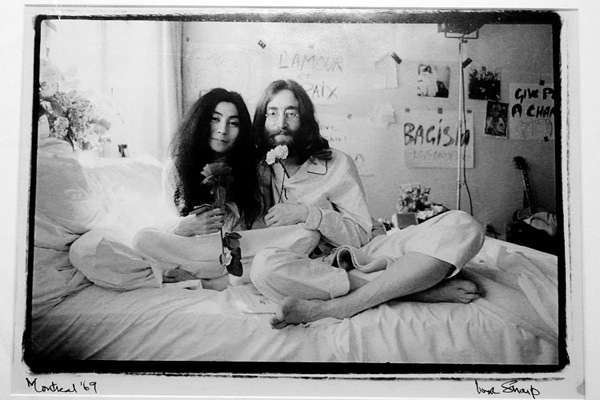John Lennon and Yoko Ono were on the Dick Cavett Show in September, 1971. Imagine had just come out. Yoko had also released a new record and a conceptual book. She’s sitting in the first chair and she’s wearing an expensive-looking, orange velvet leotard. Skimpy. She’s got on sheer black stockings and a little beret. Dick Cavett asks her if she speaks Japanese, which he immediately realizes is horrible and offensive, even if he was kidding, which isn’t clear. Cavett somehow manages to smooth talk his way through shame and embarrassment even as he experiences it, and shows his vulnerability to the audience. Very gifted, that guy. He goes on to tell Lennon that the song “Oh Yoko” reminds him of a chewing gum jingle. Cavett gets away with this insult, too, maybe because he has pretty blonde hair and a nice voice.
John and Yoko hold hands a lot during the interview and fondly stroke each other’s fingers. She’s rather humorless, deferential: what a weird position for her. The world saw her only as the wife of a Beatle. And America wasn’t quite ready for the fact that she was Japanese. It’s barely ready for it now. Maybe still not ready for it, actually. Dick Cavett points out that Ono went to Sarah Lawrence. I did not know that! But it doesn’t surprise me at all. She was out there, a woman making things, a female artist, a sharp mind. I suspect she and Lennon were love addicted. This is my layman’s diagnosis. Or maybe they were happily married, no drama, no codependency, no cray-cray. It’s possible, but not probable.
This is the thing about love addiction, it often happens INSIDE a marriage. It’s not like sex addiction, which I don’t associate as much with marriage. Of course sex addiction happens inside a marriage, too. But our stereotyped view of it, or mine at least, looks more like the plot of Looking for Mr Goodbar or that movie Shame. In Shame (aptly titled) the lead character runs around having sex with a string of anonymous women, whoever will have him, really. Pia Mellody’s book deals more with the monogamous model: a cycle of chasing and begging for love that alternates with an opposite behavior, called love avoidance. Sometimes one partner chases, and the other is distant and avoidant. Other times the partners continually switch roles, in a cycle of come-here-go-away which is excruciating for both. Mellody’s recovery program for love addiction requires tackling intimacy fears and healing wounds from childhood abandonment, abuse, and neglect. FUN!
If you’ve ever been in love, then you know that love can feel like a drug. It’s a thin line between love and love addiction. If a love relationship is bringing more pain than pleasure, probably the best idea is to get out of it. And if you can’t get out of it, maybe you’re addicted to it. But some of us are married, and we don’t want to get out.
This not to say that I’m not happily married. I am so happily married it’s a joke. Every day and every night is heaven. Every minute of my marriage is pure bliss. We fell in love, and we have never stopped being madly and passionately in love. The sex is always great. We’ve been together for twenty years and we’ve never had a fight. It’s really quite something. Therefore . . . Facing Love Addiction is not a book I would ever need to read. A therapist would never practically force me to buy this book after begging me for years to look into codependency treatment. I am way too perfect. But this book may have value for other people.
As an aside, my parents got divorced after being married for thirty years and now they don’t speak at all. Fortunately, they also had one of those marriages that was all bliss, all the time. It was the perfect relationship.
Just kidding.
Oh, and here’s the Dick Cavett Interview. Be warned, it’s a bit of a one-hour wormhole.

